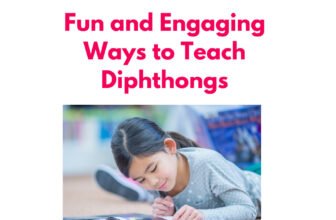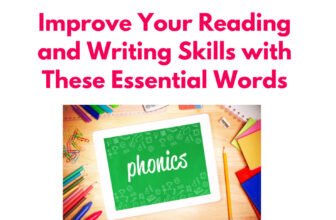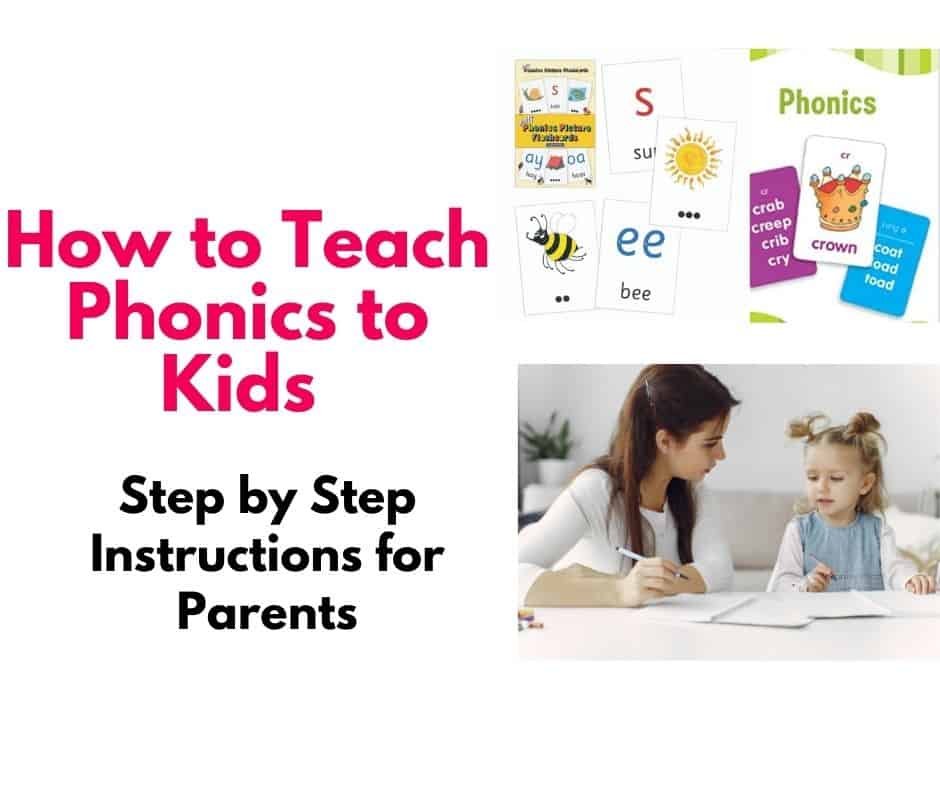
Looking for effective ways to teach your kids about consonant blends? Our comprehensive guide offers top strategies and tips to help your child master these crucial phonics skills and become a confident reader and writer. Discover fun and engaging activities, expert advice, and helpful resources to support your child’s learning journey. Start teaching consonant blends today!
Learning how to read is one of the most fundamental skills that children need to develop. And when it comes to reading, mastering consonant blends is a crucial step. Consonant blends are two or three consonant sounds that come together, such as “bl,” “tr,” and “spl.” As a parent or teacher, helping kids understand and read these blends can be a daunting task. But fear not! With the right strategies and techniques, teaching consonant blends to kids can be a fun and engaging experience for both you and your child. In this guide, we’ll explore some of the top strategies for teaching consonant blends to kids and provide tips, tricks, and resources to help make the learning process a success.
Also Read – How to Teach Phonics to Kids (Step by Step Instructions for Parents)
What are consonant blends and digraphs?
Consonant blends
Consonant blends are two or more consonant sounds that appear together in a word but each sound is pronounced individually. For example, in the word “black,” the “bl” sound is a consonant blend. Blends can appear at the beginning or end of words, and they create a new sound that is different from the individual sounds of the letters.
Digraphs:
Digraphs, on the other hand, are two letters that create a new sound when they appear together. There are two types of digraphs: consonant digraphs and vowel digraphs. Consonant digraphs are made up of two consonants, and they create a unique sound. For example, “ch” in “chip” or “sh” in “ship” are consonant digraphs. Vowel digraphs are made up of two vowels, and they also create a unique sound. Examples of vowel digraphs include “ai” in “train” or “oa” in “boat.”
Teaching kids about consonant blends and digraphs is important because it helps them develop phonemic awareness, which is the ability to recognize and manipulate individual sounds in words. This is a crucial skill for learning to read and write.
By practicing identifying and pronouncing consonant blends and digraphs, kids can improve their reading fluency and comprehension. It’s important to provide plenty of opportunities for kids to practice these skills, both in isolation and in context, through activities like games, puzzles, and reading aloud.
Also read – How to teach CVC words to kids – fun ways that really work
What are Common blends and digraphs?
When teaching phonics, it’s important to introduce and practice common blends and digraphs with your child. Knowing these blends and digraphs will help your child recognize and decode words more quickly and accurately, improving their reading fluency and comprehension.
List of Common Consonant Blends:
- Bl: “black,” “blue,” “blanket”
- Br: “brown,” “branch,” “brave”
- Cl: “clap,” “clean,” “clock”
- Cr: “crop,” “crash,” “crown”
- Dr: “dress,” “drive,” “drop”
- Fl: “flag,” “flower,” “flood”
- Fr: “frog,” “friend,” “frost”
- Gl: “glad,” “glass,” “globe”
- Gr: “grass,” “green,” “grow”
- Pl: “plan,” “plant,” “play”
- Pr: “price,” “princess,” “printer”
- Sc: “scared,” “scissors,” “scrape”
- Sk: “sky,” “skip,” “skin”
- Sl: “slip,” “sleep,” “slow”
- Sm: “small,” “smart,” “smile”
- Sn: “snack,” “snap,” “snow”
- Sp: “spoon,” “spin,” “spider”
- St: “star,” “stop,” “story”
- Sw: “swim,” “swing,” “sweet”
List of consonant digraphs:
- Ch: “chat,” “chin,” “church”
- Gh: “ghost,” “enough,” “ghetto”
- Kn: “knee,” “know,” “knock”
- Ph: “phone,” “phrase,” “photograph”
- Sh: “ship,” “shop,” “shoulder”
- Th: “think,” “thumb,” “this”
- Wh: “when,” “which,” “white”
- Wr: “wrap,” “write,” “wrong”
What should I teach first digraphs or blends?
When teaching phonics to young children, it is typically recommended to teach consonant blends before digraphs. The reason for this is that blends are easier for children to learn and they occur more frequently in words than digraphs.
Consonant blends are two or three consonant sounds that are blended together but are still pronounced independently, such as “bl,” “cr,” and “st.” These are easier for children to learn because they do not change the sound of the individual letters. Instead, they create a new sound by blending the sounds together.
Digraphs, on the other hand, are two letters that represent a single sound, such as “ch,” “sh,” and “th.” These can be more difficult for children to learn because they involve a more complex relationship between the letters and the sounds they represent.
That being said, every child is different and may learn at their own pace. So, it’s important to assess the child’s readiness and understanding of phonics concepts and adjust the teaching strategy accordingly. However, in general, it is a good idea to introduce consonant blends before digraphs.
Also Read – Fun and Easy Ways to Teach Digraphs to Kids: Discover the Secret Code of Sounds
Is there an order in which consonant blends are to be taught to kids?
Yes, there is a general order in which consonant blends are typically taught to kids. It is usually best to start with the most common and simple blends, such as “bl,” “br,” “cl,” “cr,” “dr,” “fl,” “fr,” “gl,” “gr,” “pl,” “pr,” “sc,” “sk,” “sl,” “sm,” “sn,” “sp,” “st,” “sw,” and “tr.”
These blends are easier for kids to pronounce and blend together compared to more complex blends such as “spl,” “spr,” “str,” “thr,” and “shr.” Once children have mastered the basic blends, they can then move on to the more challenging ones.
How do you explain consonant blends to kids?
Here are some steps you can follow to explain consonant blends to kids:
- Introduce the concept: Begin by explaining to the child what a consonant blend is. Tell them that it is when two or more consonant sounds are blended together in a word, but each letter sound is still heard.
- Show examples: Provide examples of words that contain consonant blends, such as “bl,” “br,” “cl,” “cr,” “dr,” “fl,” “fr,” “gl,” “gr,” “pl,” “pr,” “sk,” “sl,” “sm,” “sn,” “sp,” “st,” and “sw.” Show the child how each letter sound is still pronounced, but they are blended together to create a new sound.
- Practice saying the blends: Have the child practice saying the blends aloud. Repeat the sound several times and encourage the child to say it with you. You can also have the child practice saying words that contain the blends.
- Reading practice: Provide the child with reading materials that contain consonant blends, such as books, flashcards, or worksheets. Encourage them to identify the blends in the words and read the words aloud.
- Writing practice: Have the child practice writing words that contain consonant blends. This will help them to remember the spelling of the blends.
- Review and reinforcement: Continue to review and reinforce the concept of consonant blends in various contexts, such as through games, songs, and activities. This will help the child to retain the information and use it in their reading and writing.
What are the Top Strategies for Teaching Consonant Blends to kids
As a phonics expert, I recommend the following top strategies for teaching consonant blends to kids:
- Start with the basics: Before diving into teaching specific consonant blends, it’s important to ensure that kids have a strong foundation in phonics and phonemic awareness. Start by reviewing individual letter sounds, short and long vowels, and simple word families (Read how to teach CVC words).
- Use visual aids: Visual aids such as flashcards, charts, and posters can help kids recognize and remember consonant blends. You can create your own visuals or find ready-made ones online. Some popular resources are these Flashcards, these Alphabet and Phonics Charts, and Phonics Posters.
- Play phonics games: Games can make learning fun and engaging for kids. There are many phonics games available that specifically focus on consonant blends. Some popular ones are like these ones.
- Read aloud: Reading aloud to kids is a great way to introduce them to new words and sounds, including consonant blends. Choose books that feature lots of blends and make a point to emphasize them when reading.
- Practice writing: Writing exercises can help reinforce learning and improve spelling skills. Encourage kids to write words containing consonant blends and to practice spelling them correctly.
- Focus on common blends: There are several common consonant blends that are good to focus on when teaching kids. These include “bl,” “br,” “cl,” “cr,” “dr,” “fl,” “fr,” “gl,” “gr,” “pl,” “pr,” “sc,” “sk,” “sl,” “sm,” “sn,” “sp,” “st,” “sw,” and “tr.”
- Use multisensory techniques: Incorporating multisensory techniques, such as tapping out sounds, using manipulatives, and tracing letters, can help reinforce learning and make it more engaging for kids.
How do you teach consonant blends to kids?
We recommend following these steps to effectively teach consonant blends to kids:
- Introduce the concept: Begin by explaining to the child what a consonant blend is. Use simple language to describe how two or more consonant sounds are blended together in a word, but each letter sound is still pronounced.
- Show examples: Provide examples of words that contain consonant blends, such as “bl,” “br,” “cl,” “cr,” “dr,” “fl,” “fr,” “gl,” “gr,” “pl,” “pr,” “sk,” “sl,” “sm,” “sn,” “sp,” “st,” and “sw.” Show the child how each letter sound is still pronounced, but they are blended together to create a new sound.
- Practice saying the blends: Encourage the child to practice saying the blends aloud. Repeat the sound several times and have the child say it with you. You can also have the child practice saying words that contain the blends.
- Reading practice: Provide the child with reading materials that contain consonant blends, such as books, flashcards, or worksheets. Encourage them to identify the blends in the words and read the words aloud.
- Writing practice: Have the child practice writing words that contain consonant blends. This will help them to remember the spelling of the blends.
- Review and reinforcement: Continuously review and reinforce the concept of consonant blends in various contexts, such as through games, songs, and activities. This will help the child to retain the information and use it in their reading and writing.
What Phonemic awareness activities can be done to teach consonant blends to kids
Teaching phonemic awareness is a crucial step in helping young children learn to read and write.
One important aspect of phonemic awareness is teaching children how to blend consonant sounds together to form words. Consonant blends are groups of two or three consonant sounds that are blended together in a word.
To make learning about consonant blends more fun and engaging, there are several phonemic awareness activities that parents and teachers can use to help children develop this skill.
We’ll explore some of the best phonemic awareness activities for teaching consonant blends to kids next:
Sound Matching Game
This activity is great for helping children recognize and identify different consonant blends.
For playing this game you need picture cards and blend sound cards that you can cut out and shuffle. Start by laying out the blend sound cards face down on the table. Have your child pick up a picture card and say the name of the object.
Then ask them to find the blend sound card that matches the beginning sound of the object. If they find a match, they get to keep the cards. You can continue playing until all the cards have been matched. This activity can be done individually or in a group.
To do this activity, you can also use a game like this one.
Blend Sorting
This activity helps children recognize and identify different blends in words. To do this activity, you can use a phonics resource that comes with pictures or words with different consonant blends that you can cut out and mix up.
Invite your child to sort the words into piles based on the blend sound they hear. Encourage them to say the words aloud as they sort them. You can also have your child write the words in the appropriate piles to work on their writing skills.
Word Building
This activity helps children practice blending sounds together to form words. To do this activity, you can use a game like this.
This resource comes with picture cards and letter cards that you can use to build words. Start by laying out the picture cards and the corresponding letter cards. Have your child pick up a picture card and sound out the letters on the letter cards to build the word that matches the picture. You can also have your child write the words they build to work on their writing skills.
Read Alouds
Reading aloud to your child is a great way to introduce them to different blends and help them hear how they are used in words. Choose books that have lots of blends in them, such as these.
As you read, point out the blends and encourage your child to say them aloud. This will help them practice recognizing blends in context and improve their reading fluency.
Writing Practice
Writing is another great way for children to practice recognizing and using blends. To help them practice, you can use the products like these.
This resource comes with worksheets that have words with different blends missing a letter. Your child can fill in the missing letters to complete the words and practice writing them. This activity can help improve their spelling and writing skills.
Sound Sorting
Provide students with a variety of objects or pictures that contain consonant blends. Have them sort the objects into groups based on the sound they hear at the beginning, middle, or end of the word. For example, sort objects into groups that start with “cl,” “st,” and “sm.” This activity helps students focus on the sounds within words and can be done with physical objects or digital resources such as online sorting games.
Word Blending
Provide students with a list of words that contain consonant blends. Ask them to identify the individual sounds in each word, then blend the sounds together to form the whole word. This activity helps students practice blending sounds together and can be done with flashcards or digital resources such as phonics apps.
Sound Substitution
Provide students with a word that contains a consonant blend. Ask them to substitute one of the sounds in the blend with a different sound, and say the resulting word. For example, if given the word “snack,” they can substitute the “s” sound with a “l” sound to make the word “lack.” This activity helps students identify the sounds within words and how they can be changed to create new words.
Sound Segmentation
Provide students with a word that contains a consonant blend. Ask them to identify the individual sounds in the word and say them out loud in order. For example, for the word “spoon,” they would say “s-p-ooh-n.” This activity helps students practice identifying the individual sounds within words and can be done with physical objects or digital resources such as phonics games.
Rhyme Recognition
Provide students with a list of words that contain consonant blends. Ask them to identify words that rhyme with each other. This activity helps students focus on the ending sounds of words and can be done with physical objects or digital resources such as online rhyming games.
What are some do and don’t for teaching consonant blends to kids
Do’s:
- Use a multisensory approach – involve the kids in various activities that cater to different learning styles, such as visual, auditory, and kinesthetic.
- Start with basic blends – begin by introducing simple blends such as “bl,” “gr,” “st,” and “fl” before moving on to more complex blends.
- Use real-life examples – incorporate real-life examples of words with consonant blends to help kids relate to the concept and understand its importance in the language.
- Practice consistently – encourage kids to practice regularly to help them reinforce their understanding and mastery of consonant blends.
- Provide positive reinforcement – praise and encourage kids for their efforts and progress to boost their confidence and motivation.
Don’ts:
- Overwhelm kids with too much information – avoid introducing too many blends at once as it can be overwhelming for kids.
- Rush through the process – take your time to ensure kids understand and can recognize the different consonant blends before moving on to new ones.
- Neglect phonemic awareness – ensure kids have a solid foundation in phonemic awareness before introducing consonant blends, as this will help them understand the relationship between sounds and letters.
- Use complex words – avoid using complex words that may confuse or frustrate kids, instead opt for simple words and sentences.
- Criticize or discourage – avoid criticizing or discouraging kids, as this can hinder their progress and motivation.
By following these do’s and don’ts, you can create a positive and effective learning environment for teaching consonant blends to kids.
How can I help my child practice and reinforce their understanding of consonant blends?
There are several ways to help your child practice and reinforce their understanding of consonant blends:
- Encourage your child to read books that contain words with consonant blends. This will help them see the blends in context and reinforce their understanding of how they are used in words.
- Play games with your child that focus on identifying and creating words with consonant blends. You can use flashcards, word-building activities, and online games to make learning fun and engaging.
- Practice oral blending and segmenting activities with your child. For example, you can say a word with a blend, such as “slip,” and have your child repeat the word and then identify the blend.
- Provide opportunities for your child to write words with consonant blends. You can use worksheets, writing prompts, and spelling games to help your child practice their spelling and writing skills.
- Finally, make sure to praise and encourage your child as they learn and master new blends. Positive reinforcement can go a long way in helping your child feel confident and motivated to learn.
What age should I start teaching consonant blends to my child?
You can start introducing consonant blends to your child around the age of 4 or 5, when they are familiar with individual letter sounds and can start blending them together.
What are some fun activities or games to help my child learn consonant blends?
There are many fun activities and games that can help your child learn consonant blends such as word matching games, rhyming games, and even using letter tiles to create words.
As a phonics expert, I often receive questions from moms regarding teaching consonant blends to their kids. Here are some of the most frequently asked questions:
What are the best resources for teaching consonant blends to my child?
There are many resources available for teaching consonant blends, such as phonics workbooks, flashcards, and online games. I recommend this workbook for a comprehensive introduction to phonics, including consonant blends. For flashcards, this set is a great option for hands-on learning.
How can I help my child pronounce consonant blends correctly?
It’s important to teach your child the correct pronunciation of each consonant blend, as mispronouncing them can lead to confusion and difficulty in reading.
One helpful strategy is to practice sounding out the individual consonants first, then blending them together. For example, for the “bl” blend, have your child practice saying “b” and “l” separately before blending them together as “bl”.
This is a fun and effective resource for teaching correct letter sounds and blending.
When should I start teaching consonant blends to my child?
Consonant blends are typically introduced in kindergarten or first grade, after a child has a strong foundation in letter recognition and phonemic awareness. However, every child is different and may be ready to learn blends at different ages.
It’s important to pay attention to your child’s readiness and not push them too hard or too early. This book set is a great resource for introducing phonics to young children.
How can I make learning consonant blends fun and engaging for my child?
One great way to make learning fun is through games and activities. This game is a fun way to reinforce consonant blends through a fast-paced matching game. Another fun activity is to make “blend bottles” by filling plastic bottles with small items that start with different consonant blends. Have your child shake the bottles and listen for the different blends. This product a fun and engaging resource for teaching phonics through stories and activities.
What are consonant blends and why are they important to teach?
Consonant blends are two or three consonant sounds that are blended together but retain their individual sounds, such as “bl” in “black” or “str” in “street”. They are important to teach because they help children recognize and sound out common letter combinations in words, which strengthens their reading and spelling skills.
At what age should I start teaching my child about consonant blends?
Children can start learning about consonant blends as early as age 4 or 5, as they begin to recognize individual letters and sounds. However, some children may not be ready for this until age 6 or 7. It is important to follow your child’s individual development and pace of learning.
What are some common mistakes to avoid when teaching consonant blends?
One common mistake is to overwhelm your child with too many blends at once. Start with one or two blends and practice them until your child is comfortable before moving on to more difficult blends. Also, avoid using nonsense words when teaching blends, as they can be confusing and not helpful for real-world reading and writing.
What do I teach after Digraph?
After teaching digraphs, the next step in phonics instruction is usually to introduce diphthongs and vowel teams. Diphthongs are two vowels that create a unique sound when combined, such as “oi” in “coin” or “au” in “haul.” Vowel teams are two vowels that are placed together to form a sound that is different from either vowel on its own, such as “ea” in “beach” or “ai” in “mail.”
In addition to introducing new vowel patterns, it’s important to continue reinforcing and reviewing digraphs with your child. This can be done through games, activities, and reading practice. As your child becomes more proficient in recognizing and decoding these patterns, they will be better equipped to tackle more complex words and texts.
In conclusion, teaching consonant blends to kids is a fun and engaging process that requires patience, practice, and perseverance. With the right strategies and resources, you can help your child become a confident reader and writer. Remember to start with simple blends and gradually increase the complexity as your child progresses. Use engaging activities, games, and books to make the learning process enjoyable and interactive. And most importantly, be supportive and encouraging of your child’s progress every step of the way. By following these tips and tricks, you can help your child master the skill of blending consonant sounds and become a proficient reader for life.






